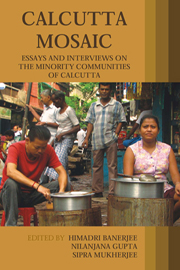Book contents
- Frontmatter
- Contents
- List of Contributors
- Acknowledgements
- Introduction
- 1 Mapping the Spaces of Minorities
- 2 The Armenians of Calcutta
- 3 The Jews of Calcutta: An Interview with Michael Ezra
- 4 The Sindhis of Calcutta
- 5 The City of Colleges
- 6 The Chinese Community of Calcutta
- 7 The Anglo–Indians of Calcutta
- 8 The Biharis of Calcutta
- 9 Agraharis of Calcutta
- 10 A Journey into My Neighbourhood
- 11 The ‘South Indians’ of Calcutta: Experiences in Cultural Processes
- 12 ‘Non-Bengali’ Icons of Malevolence
- 13 Selfing the City
1 - Mapping the Spaces of Minorities
Calcutta through the Last Century
Published online by Cambridge University Press: 05 March 2012
- Frontmatter
- Contents
- List of Contributors
- Acknowledgements
- Introduction
- 1 Mapping the Spaces of Minorities
- 2 The Armenians of Calcutta
- 3 The Jews of Calcutta: An Interview with Michael Ezra
- 4 The Sindhis of Calcutta
- 5 The City of Colleges
- 6 The Chinese Community of Calcutta
- 7 The Anglo–Indians of Calcutta
- 8 The Biharis of Calcutta
- 9 Agraharis of Calcutta
- 10 A Journey into My Neighbourhood
- 11 The ‘South Indians’ of Calcutta: Experiences in Cultural Processes
- 12 ‘Non-Bengali’ Icons of Malevolence
- 13 Selfing the City
Summary
The spatial concentration of communities, with transformations over time has been a neglected theme in academic research on Indian cities. Thus, when I was asked to present a broad overview of the organization of minority communities in the city space of Calcutta, a number of questions immediately came to my mind. First, how would one define ‘minorities’? Second, has there been any change in the concentration/dispersal of minorities over space? Can one identify the factors behind such changes? Third, can one identify the major phases in the development of minority settlements in Calcutta?
The decennial census, the only source of a consistent time-series demographic data, provides us with figures on the two broad groupings into which minorities are generally classified: religious and linguistic. The limitation of this database, however, is that the census authorities have discontinued the publication of either religious or linguistic categories at the level of the municipal wards, since 1961. Yet, one cannot make meaningful spatial analysis unless such micro-level figures are made available. The existing ward-level data prior to 1961, though not fully comparable over time, due either to changes in the method or subject of enumeration, gives a broad indication of the transformations, if any, in the organization of minorities over space.
Very few sources exist, apart from demographic data mentioned above, that could provide some clue as to the concentration of communities over space in the city of Calcutta, historically.
- Type
- Chapter
- Information
- Calcutta MosaicEssays and Interviews on the Minority Communities of Calcutta, pp. 23 - 70Publisher: Anthem PressPrint publication year: 2009
- 3
- Cited by



